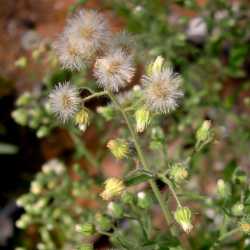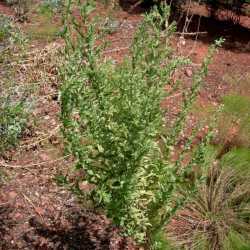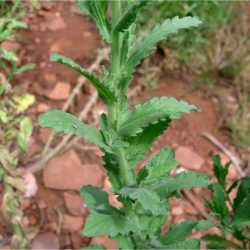|
|
 Flowers and fruit Max Licher @http://swbiodiversity.org, Usage Rights: Creative Commons Attribution-ShareAlike (CC BY-SA) |  Plant Max Licher @http://swbiodiversity.org, Usage Rights: Creative Commons Attribution-ShareAlike (CC BY-SA) |  Leaves Max Licher @http://swbiodiversity.org, Usage Rights: Creative Commons Attribution-ShareAlike (CC BY-SA) | | | |
|
Origin:
Native
Life Cycle:
Annual
General Desc:
Herb with taproot; stems glandular or covered with sticky hairs which resemble spider's web (arachnoid).
Identification notes: Stems and leaves glandular or viscid; leaves more or less serrated or divided into deep narrow irregular segments. Flower heads without ray flowers, the disc flower are about half as long as the tuft of hairs on each seed.
Height:
4 to 40 inches
Habitat Description: Found in ditch banks, dry stream beds and disturbed sites.
Plant Communities:
Desert Scrub, Interior Chaparral, Semidesert Grasslands, Pinyon Juniper Woodland, Montane Conifer Forest, Riparian, Disturbed Areas
Elevation: 1500 - 9000 feet
Color:
Whitish
Shape:
Daisy or dandelion-like in elongated clusters
Tubular:
N
Flowering Period:
Sep - Oct
Description:
Disc flowers only along elongated, branched stems, 5 to 20 per flower stem; 2 to 5 bracts (phyllaries) cone-shaped, 1/8 inch diameter; 60 to 100 female whitish flowers ring the edges of flower heads.
Leaf Color:
Green
Leaf Type:
Simple
Leaf Shape:
Narrow
Leaf Margin:
Toothed
Leaf Attachment:
Basal and alternate
Leaves Clasp:
Y
Hairs:
Leaves and stems
Spines:
N
Leaf Description:
When plant is young, leaves form a densely hairy basal rosette; after plant bolts, leaves alternate along the stem, mostly sessile and clasping; blades oblong, 3/4 to 2 inches long and 1/4 to 3/4 inch wide, many irregularly toothed or obscurely lobed.
Fruit Color: Whitish
Fruit Type: Achene
Fruit Notes: Achenes <1/16 inch long, pale tan, topped with a pappus of 10 to 30 fragile and easily deciduous whitish bristles.
|
|